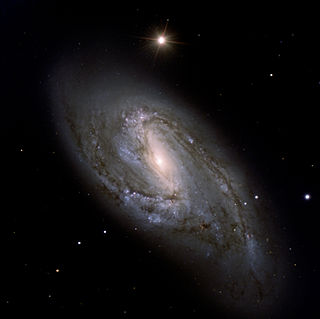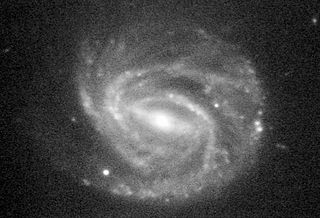
Messier 83 or M83, also known as the Southern Pinwheel Galaxy and NGC 5236, is a barred spiral galaxy approximately 15 million light-years away in the constellation borders of Hydra and Centaurus. Nicolas-Louis de Lacaille discovered M83 on 17 February 1752 at the Cape of Good Hope. Charles Messier added it to his catalogue of nebulous objects in March 1781.

Messier 61 is an intermediate barred spiral galaxy in the Virgo Cluster of galaxies. It was first discovered by Barnaba Oriani on May 5, 1779, six days before Charles Messier discovered the same galaxy. Messier had observed it on the same night as Oriani but had mistaken it for a comet. Its distance has been estimated to be 45.61 million light years from the Milky Way Galaxy. It is a member of the M61 Group of galaxies, which is a member of the Virgo II Groups, a series of galaxies and galaxy clusters strung out from the southern edge of the Virgo Supercluster.

Messier 66 or M66, also known as NGC 3627, is an intermediate spiral galaxy in the southern, equatorial half of Leo. It was discovered by French astronomer Charles Messier on 1 March 1780, who described it as "very long and very faint". This galaxy is a member of a small group of galaxies that includes M65 and NGC 3628, known as the Leo Triplet or the M66 Group. M65 and M66 are a common object for amateur astronomic observation, being separated by only 20′.

NGC 4725 is an intermediate barred spiral galaxy with a prominent ring structure, located in the northern constellation of Coma Berenices near the north galactic pole. It was discovered by German-born British astronomer William Herschel on April 6, 1785. The galaxy lies at a distance of approximately 40 megalight-years from the Milky Way. NGC 4725 is the brightest member of the Coma I Group of the Coma-Sculptor Cloud, although it is relatively isolated from the other members of this group. This galaxy is strongly disturbed and is interacting with neighboring spiral galaxy NGC 4747, with its spiral arms showing indications of warping. The pair have an angular separation of 24′, which corresponds to a projected linear separation of 370 kly. A tidal plume extends from NGC 4747 toward NGC 4725.

NGC 2841 is an unbarred spiral galaxy in the northern circumpolar constellation of Ursa Major. It was discovered on 9 March, 1788 by German-born astronomer William Herschel. J. L. E. Dreyer, the author of the New General Catalogue, described it as, "very bright, large, very much extended 151°, very suddenly much brighter middle equal to 10th magnitude star". Initially thought to be about 30 million light-years distant, a 2001 Hubble Space Telescope survey of the galaxy's Cepheid variables determined its distance to be approximately 14.1 megaparsecs or 46 million light-years. The optical size of the galaxy is 8.1′ × 3.5′.

NGC 4088 is an intermediate spiral galaxy in the constellation Ursa Major. The galaxy forms a physical pair with NGC 4085, which is located 11′ away.

NGC 4666 is a spiral galaxy in the equatorial constellation of Virgo, located at a distance of approximately 55 megalight-years from the Milky Way. It was discovered by the German-born astronomer William Herschel on February 22, 1784. It is a member of the Virgo II Groups, a series of galaxies and galaxy clusters strung out from the southern edge of the Virgo Supercluster. John L. E. Dreyer described it as "bright, very large, much extended 45°±, pretty suddenly brighter middle". It is a member of an interacting system with NGC 4668 and a dwarf galaxy, and belongs to a small group that also includes NGC 4632.

NGC 5668 is a nearly face-on spiral galaxy, visual magnitude about 11.5, located about 81 million light years away in the constellation Virgo. It was discovered on 29 April 1786 by William Herschel.

NGC 1084 is an unbarred spiral galaxy in the constellation Eridanus. It is located at a distance of about 63 million light-years away from the Milky Way. The galaxy was discovered by William Herschel on 10 January 1785. It has multiple spiral arms, which are not well defined. It belongs in the same galaxy group with NGC 988, NGC 991, NGC 1022, NGC 1035, NGC 1042, NGC 1047, NGC 1052 and NGC 1110. This group is in turn associated with the Messier 77 group.

NGC 1964 is a barred spiral galaxy in the constellation Lepus. The galaxy lies 65 million light years away from Earth, which means, given its apparent dimensions, that NGC 1964 is approximately 100,000 light years across. At its center lies a supermassive black hole, with estimated mass 2.5 × 107M☉. The galaxy features two tightly wound inner spiral arms within a disk with high surface brightness and two outer, more open spiral arms that originate near the inner ring. The outer arms feature few small HII regions.

NGC 2280 is a spiral galaxy located in the constellation Canis Major. It is located at a distance of about 75 million light years from Earth, which, given its apparent dimensions, means that NGC 2280 is about 135,000 light years across. It was discovered by John Herschel on February 1, 1835.

NGC 7606 is a spiral galaxy located in the constellation Aquarius. It is located at a distance of circa 100 million light years from Earth, which, given its apparent dimensions, means that NGC 7606 is about 165,000 light years across. It was discovered by William Herschel on September 28, 1785. The galaxy is included in the Herschel 400 Catalogue. It lies 45 arcminutes northeast from psi2 Aquarii. It can be seen with a 4 inch telescope but its visibility is greatly affected by light pollution.

NGC 7723 is a barred spiral galaxy located in the constellation Aquarius. It is located at a distance of about 90 million light years from Earth, which, given its apparent dimensions, means that NGC 7723 is about 95,000 light years across. It was discovered by William Herschel on November 27, 1785. The galaxy is included in the Herschel 400 Catalogue. It lies 1.5 degrees north-northwest from Omega1 Aquarii. It can be seen with a 4-inch telescope under dark skies.

NGC 2835 is an intermediate spiral galaxy located in the constellation Hydra. It is located at a distance of circa 35 million light years from Earth, which, given its apparent dimensions, means that NGC 2835 is about 65,000 light years across. It was discovered by Wilhelm Tempel on April 13, 1884. NGC 2835 is located only 18.5 degrees from the galactic plane.

NGC 3367 is a barred spiral galaxy located in the constellation Leo. It is located at a distance of about 120 million light years from Earth, which, given its apparent dimensions, means that NGC 3367 is about 85,000 light years across. It was discovered by William Herschel on March 19, 1784.

NGC 6907 is a spiral galaxy located in the constellation Capricornus. It is located at a distance of about 120 million light-years from Earth, which, given its apparent dimensions, means that NGC 6907 is about 115,000 light-years across. It was discovered by William Herschel on July 12, 1784. The total infrared luminosity of the galaxy is 1011.03 L☉, and thus it is categorised as a luminous infrared galaxy.

NGC 753 is a spiral galaxy located 220 million light-years away in the constellation Andromeda. The galaxy was discovered by astronomer by Heinrich d'Arrest on September 16, 1865 and is a member of Abell 262.

NGC 7531 is an intermediate spiral galaxy located in the constellation Grus. It is located at a distance of about 70 million light-years from Earth, which, given its apparent dimensions, means that NGC 7531 is about 95,000 light years across. It was discovered by John Herschel on September 2, 1836.

NGC 7418 is an intermediate spiral galaxy located in the constellation Grus. It is located at a distance of circa 60 million light-years from Earth, which, given its apparent dimensions, means that NGC 7418 is about 60,000 light-years across. It was discovered by John Herschel on August 30, 1834.

NGC 2525 is a barred spiral galaxy located in the constellation Puppis. It is located at a distance of about 70 million light years from Earth, which, given its apparent dimensions, means that NGC 2525 is about 60,000 light years across. It was discovered by William Herschel on February 23, 1791.




















